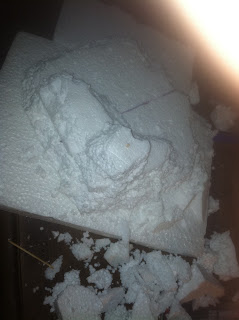When I paint women, I find it useful to fall in love with them. What would they be like if they were life sized and alive, or if I were 28mm scale and metal? What would our relationship be like? Our lovemaking, would it be playful? Soulful? Slippery? This trio was part of the Celtos line, I forget what manufacturer makes them. They're not necessarily my favorite line of figs because their tendency is to be a little cartoonish, with swords as broad as ironing boards, and features like the gigantic hair of their barbarian queen.
I'd like you to hum "barbarian queen" to the tune of Billy Ocean's "Caribbean Queen" while you read this post. If you can't remember the tune, here's a
link.
While not my favorite line, Celtos did make a pack that was hard for me to resist buying (off eBay): Two warrior-maidens carry their queen on a big shield. These girls are easy to love. A Vallejoish design philosophy informs the sculpts. The servility of the maidens is balanced by the dominance of their queen. The queen has a breastplate and the servants each have a tit-napkin covering their chests, and nobody is wearing pants, yet, in a wonderfully Celtic dichotomy, everybody has cold weather boots (a contrast which I have intensified by putting white fur on the boots). Big tits and big hair call to me, a child of the 80s, with the dulcet tones of a Motley Crue power ballad -- or the soundtrack to Heavy Metal.
I didn't do anything too innovative here. I did take my first attempt at what the mini painter's Internet calls "Bette Davis eyes" . Here's the process:
1) Paint eyes early, whites first, pupils second.
2) surround the eyes with a ring of a very dark flesh color (here I've used black, which looks okay if anachronistically mascara-like on these girls, but won't be my preference for future Bette Davis eyes).
3) paint the face in as your normally would, making sure you leave a that dark ring around the eye area. A dark circle around eyes makes them pop, as anyone who wears makeup would know, but I'm just finding out.
Here Bette Davis eyes were difficult because all of these ladies had canopy-bangs that made it tough to get precise brush strokes in there.
You'll note that the darkest areas on these women's skin are reddish. The shadow/basecoat on a Mediterranean are olive, the shadows on a Persian's skin are brown, and on an Indian they're purple. In doing this, I realize that I am painting my skin tones partially realistic, partially expressionistic.
Hair is solid color, darker wash, final drybrush with a slightly lighter than original version of the first color. Metal areas got light base, dark wash, highlight with the same or lighter light base.
Regrettably, these saucy wenches don't have anything to do with any game I play or any army I field. They were just too fine not to paint. Stayed up til 5 in the morning with these wenches, but this was all done in a single day! The toughest decision was which hair color went where. My personal fondness for dark hair made me want to put the
brunette on top, but in the end, red hair is so much more dramatic that there really was no argument.

















